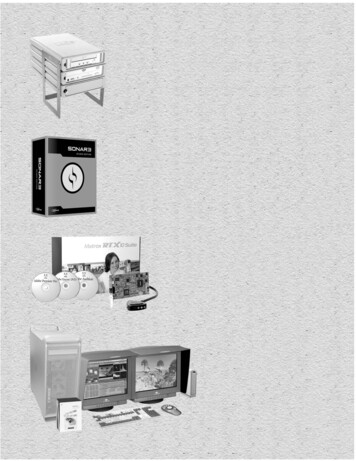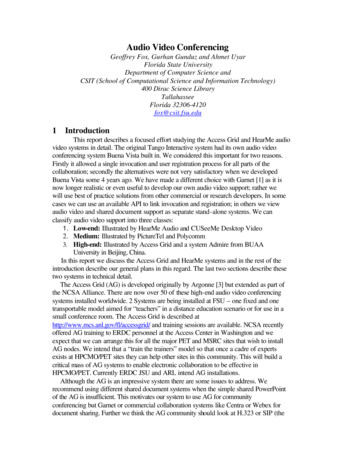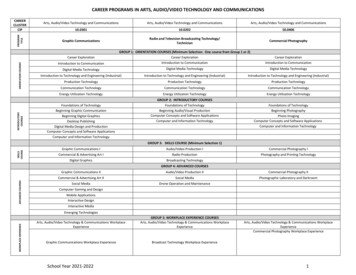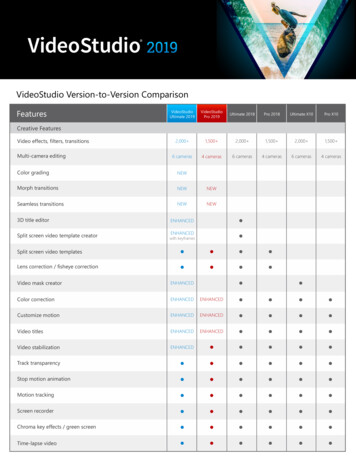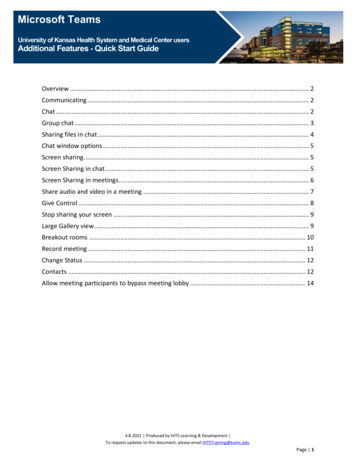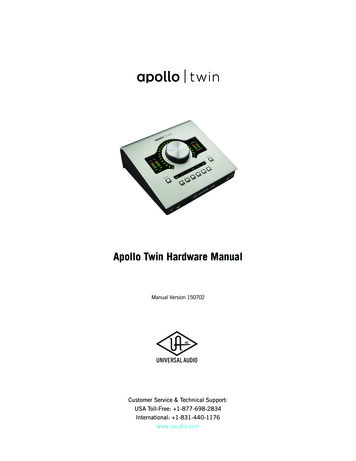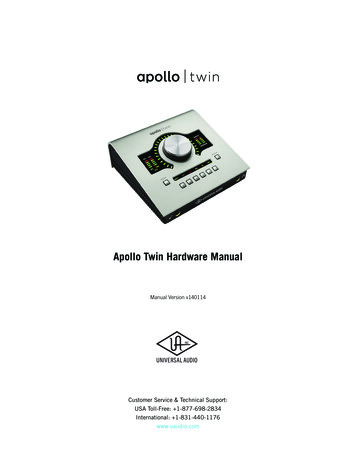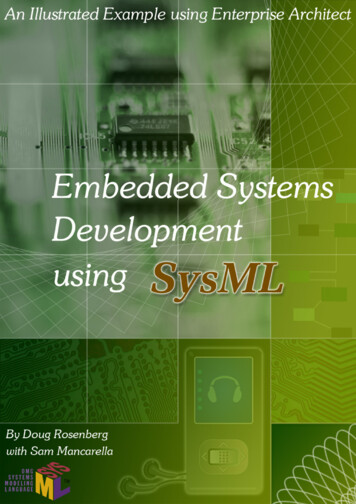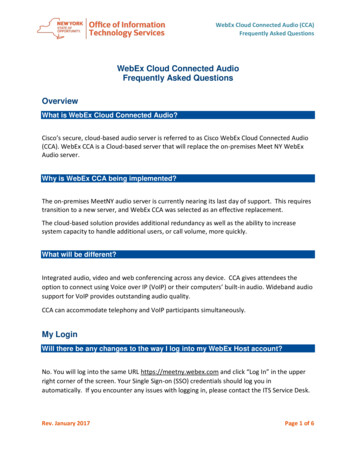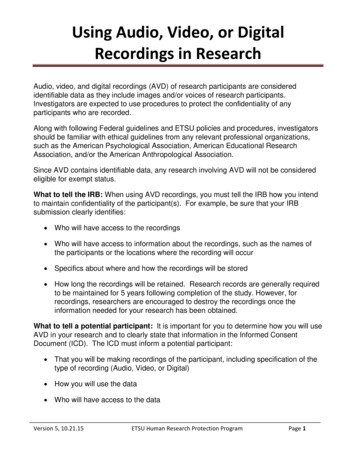
Transcription
Using Audio, Video, or DigitalRecordings in ResearchAudio, video, and digital recordings (AVD) of research participants are consideredidentifiable data as they include images and/or voices of research participants.Investigators are expected to use procedures to protect the confidentiality of anyparticipants who are recorded.Along with following Federal guidelines and ETSU policies and procedures, investigatorsshould be familiar with ethical guidelines from any relevant professional organizations,such as the American Psychological Association, American Educational ResearchAssociation, and/or the American Anthropological Association.Since AVD contains identifiable data, any research involving AVD will not be consideredeligible for exempt status.What to tell the IRB: When using AVD recordings, you must tell the IRB how you intendto maintain confidentiality of the participant(s). For example, be sure that your IRBsubmission clearly identifies: Who will have access to the recordings Who will have access to information about the recordings, such as the names ofthe participants or the locations where the recording will occur Specifics about where and how the recordings will be stored How long the recordings will be retained. Research records are generally requiredto be maintained for 5 years following completion of the study. However, forrecordings, researchers are encouraged to destroy the recordings once theinformation needed for your research has been obtained.What to tell a potential participant: It is important for you to determine how you will useAVD in your research and to clearly state that information in the Informed ConsentDocument (ICD). The ICD must inform a potential participant: That you will be making recordings of the participant, including specification of thetype of recording (Audio, Video, or Digital) How you will use the data Who will have access to the dataVersion 5, 10.21.15ETSU Human Research Protection ProgramPage 1
Using Audio, Video, or DigitalRecordings in Research How you will protect the participant’s identity Where the recordings will be stored How the recordings will be kept secure When recordings will be destroyedSAMPLE TEXT FOR INFORMED CONSENT DOCUMENT INVOLVING AVDThis study involves the use of audio or video recordings (specify which) for the purposeof . Only will haveaccess to this data. Neither your name nor any other identifying information will beassociated with the audio or video recording or the transcript. This data will be keptsecure by and will be destroyed .If your study will allow recording to be an optional part of the research, then asuggested approach is to include checkboxes similar to those indicated below. I DO NOT agree to audio (video) taping. I agree to audio (video) taping.USES OF THE RECORDING BEYOND SINGLE ANALYSISFOR A RESEARCH STUDYUsing the recording for presentations/education: If you intend to use the AVD inpresentations and education, you must include this information in the original ICD. TheICD should list all the possible ways you would like to use the recordings. These optionsmight include: Conference presentations Education of future investigators Publications (both physical and digital)Version 5, 10.21.15ETSU Human Research Protection ProgramPage 2
Using Audio, Video, or DigitalRecordings in ResearchParticipants should have the option to choose whether the investigator can use all orsegments of AVD in any of these ways. You may also decide to give the participant theopportunity to review the recording after it is complete. This is particularly important if thematerial is of a sensitive nature.Recordings cannot be used in any manner other than those consented to by theparticipant.SAMPLE CHECKBOXES FOR INFORMED CONSENT DOCUMENT INVOLVING AVDAND USE OF AVD FOR EDUCATION/PRESENTATIONSIn addition to the requirements above, the IRB recommends including applicablecheckboxes, with instructions in the ICD for the participant to select the boxes inaccordance with their wishes. An example follows.In addition to analyzing your recording for this research study, we would like to ask yourpermission to use excerpts from your recording for other purposes. You can choosewhether you want to allow your recording to be shared. If you choose to allow us toshare your recording, we will not use your name or other identifying information in anyreport, publication, or presentation. Please tell us your decision(s) by placing a checkbeside your choice(s). The recording can ONLY be studied by the research team for use in theresearch project and CANNOT be published or used in any presentations.OR if you agree to share your recordings, please mark your choice(s) below: I agree that my recording can be shown in public presentations toscientific/nonscientific groups. I agree that my recording can be shown to participants in other researchstudies. I agree that my recording can be used for scientific publications. I agree that my recording can be shown in classrooms to students foreducation and trainingYour signature indicates that you have read the information and made a decisionabout how your recording may be used.Version 5, 10.21.15ETSU Human Research Protection ProgramPage 3
Using Audio, Video, or DigitalRecordings in ResearchPlease note that if the recordings will be posted and or distributed in such a manner thatothers could access, use and/or disclose the recordings, this must be included in the ICDand agreed to by the participant. See the section below.Using the recording for broader purposes or in settings with limited or no control(i.e., internet, distribution to non-ETSU archive):If possible, filtering and masking should be used in order to allay concerns regardingconfidentiality and privacy. However, the IRB recognizes that these techniques areoften prohibitively expensive or may obscure the necessary information.We recommend meeting with the IRB Chair/Vice-Chair to prospectively plan a projectthat would include asking permission of participants to share their recordings oninternet sites, etc. Many sites, such as Databrary, have a template data release andother related information items that are helpful to researchers and the IRB in planningthese studies. AVD may not be used or distributed in any way that is not approved bythe IRB.ARCHIVING AVDSometimes, in addition to analyzing AVD for a specific research project and/or specificuse as noted above, researchers want to maintain the AVD for future use.Will your project include any of the following elements? the storage of AVD for future research projects an intent for the AVD to be used repeatedly for research purposes an intent to maintain the AVD to share the data and/or specimens with otherinvestigatorsIf so, then your study includes what the IRB calls a “repository”.If your project will include a repository aspect, you have two options for submitting to theIRB:1. You can include relevant information about the repository in your new protocolsubmission2. You can submit a separate new protocol submission, and obtain a separateapproval for the repository. While this is more work in the beginning, it often resultsVersion 5, 10.21.15ETSU Human Research Protection ProgramPage 4
Using Audio, Video, or DigitalRecordings in Researchin more clarity. If you will be adding data from other studies to the repository, youmust choose this option.With either option, you will need to include detailed information about the 3 stages of arepository:1. Collection of data2. Storage of data3. Distribution of dataSee Repository Guidance for more detailed information about what to include in yoursubmission to the IRB. Please note that each future analysis of private identifiableinformation for research purposes must be presented to the IRB as separate protocolsthat may not commence until IRB review and approval (e.g., separate IRBapproval/determination will be required for each specific project that uses identifiabledata/specimens). The IRB will need to determine whether new use of the archived AVDis related to the original protocol and informed consent and ensure that it does not put theparticipant in any greater risk.The IRB will include consideration of the following when reviewing any new protocolsinvolving archived AVD: Whether the new use increases risk Whether the participants consented to possible future use of this data How the participants’ confidentiality is being maintained and whether this new usewould compromise their confidentialityThe IRB may require the investigator to contact the participants to obtain informedconsent for the proposed new use.If you want to ask permission to allow AVD to be archived in a repository, the IRB will behappy to assist you in designing your informed consent. The ICD should includedisclosure of the following (in addition to other requirements): a general description of the concept and purpose of repositories conditions under which information will be released to investigators information about whether participants would be able to withdraw their materialsfrom further study description of the provisions for protecting privacy/confidentialityVersion 5, 10.21.15ETSU Human Research Protection ProgramPage 5
Using Audio, Video, or DigitalRecordings in Research statement describing the future use of the data as specifically as possible specific risks related to a breach of confidentiality relative to the information beingcollected indication of whether the participants would be contacted with incidental findings orre-contacted in the future for future researchPlease contact the IRB for additional assistance and/or information.Phone: 423-439-6053Fax: 423-439-6060Email: Olivef@etsu.eduVersion 5, 10.21.15ETSU Human Research Protection ProgramPage 6
information for research purposes must be presented to the IRB as separate protocols that may not commence until IRB review and approval (e.g., separate IRB approval/determination will be required for each specific project that uses identifiable data/specimens). The IRB will need to determine whether new use of the archived AVD
